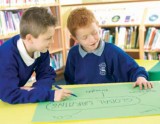Give children’s writing a genuine purpose with this campaigning literacy lesson from Alison Wilcox...
It is important to give children’s writing a real purpose and audience, and not to confine their efforts to school jotters or classroom displays. An understanding of how their work fits into a wider context will inspire them to write and fully engage with the learning process.
Global warming is an issue that children have readily embraced. The ‘Reduce, Reuse, Recycle’ slogan has been particularly successful in imparting the message about what action they can take, and how they can influence their parents to act as well.
With the conference on climate change due to take place in Denmark in December, the issue of global warming will once again become front page news and the subject of much discussion. Therefore, it provides an ideal opportunity for children to have a real purpose and audience for their writing and experiment with the ‘vehicle’ for their message.
The most memorable advertising campaigns make use of poetic rhythm to impart their message. This activity aims to show children that poetry can be an effective vehicle to communicate ideas and images using a few carefully chosen words. Their audience is the Prime Minister and the UN International Panel of Climate Change. Work should be sent to:
Gordon Brown
10 Downing Street
London
SW1A 2AA
UN International Panel on Climate Change
7bis Avenue de la Paix
C.P.2300
CH-1211
Geneva, Switzerland

Before children can go on to express their views on globalwarming, it’s important they have an overview of the causes and effects. As a class, you should work towards a brief summary.
The causes
“Carbon dioxide and other gases warm the surface of the planet by trapping heat from the sun in the atmosphere. By burning fossil fuels, such as coal, oil and gas, and clearing forests, the amount of carbon dioxide in the Earth’s atmosphere has increased dramatically and temperatures are rising.”
The effects
• Sea level – glaciers melting in Antarctica and Greenland result in rising sea levels. The Arctic Ocean could be ice free in fifty years.
• Animals and plants – wildlife cannot adapt quickly enough to survive if there is a rapid change in climate, and species will become extinct. E.g. Polar bears will starve or have to find new land on which to hunt and live if the Arctic ice melts.
• Storms – hurricanes and tornadoes happen more frequently.
• Flooding – coastal regions and low-lying areas like the Netherlands and Bangladesh may be flooded.
• Heat waves – these will become more frequent and intense, and could result in bush fires.
• Droughts – result in a shortage of food in affected areas, as insufficient crops can be grown to support the population. Activities
• Produce a mind map of the effects of global warming.
• Draw a box in the centre of the page containing a summary: a rise in carbon dioxide leads to a rise in temperature.
• Use the six headings above to create a spider’s web of the effects.
To help put this information into context, watch the great melt on BBC iPlayer (duration 1 hour).
Activities

• The melting Arctic ice has particular consequences for the polar bear. Ask children to watch carefully and identify what these are.
• There are excellent books available, which could also be used as a stimulus for discussion of specific issues connected to global warming. The following websites are also a good source for information, games and activities: http://www.clean-air-kids.org.uk/globalwarming or http://epa.gov/climatechange/kids
Referring back to the mind map they produced earlier, children should now write additional verses for the poem below. This is a good exercise for experimenting with powerful and expressive verbs. It also gives children the opportunity to convey feelings, reflections or moods in a poem through the careful choice of words and phrases.
The day is dawning
When global warming
Cannot be ignored
Ice caps are melting
Polar bears are sweating
Temperatures have soared
It’s time to act
And make a pact
To make our voices heard
Alison Wilcox & Kitty Stevenson (aged 10)
Enlarge the poem and read it with the class.
Discuss the message that it is trying to convey: that we need to speak up and persuade politicians to act to stop ice caps melting and polar bears becoming extinct.
Explain to the children that they are going to use their global warming mind maps, drafted in a previous lesson, to write additional verses for the poem above. They can begin by rewriting the second verse, perhaps keeping the last line, “Temperatures have soared”.
Before writing the new verses, take each of the headings on the mind map and brainstorm additional nouns. For example, storms – hurricanes, dust storms, tornadoes. Then think up a list of powerful verbs.
| Themes | Layer Description | Stranded |
|---|---|---|
| Sea level | Wheat | Shrinking |
| Storms | Crops | Withering |
| Flooding | Seals | Cracking |
| Heat wave | Penguins | Tearing |
| Streams/Rivers | Polar Bears | Whipping |
| Drought | Earth | Exploding |
| Ground | Scarring | |
| Dust | Starving | |
| Deserts | Flooding/spilling | |
| Wildfires | Raging | |
| Hurricanes, wind, tornadoes | Roaring | |
| People | ||
| Rivers |
Activities
• Children should complete a list of nouns and verbs.
• Ask them to experiment with different combinations until they get the required image (e.g wildfires raging, crops withering.)
• Cut up each of the noun/verb combinations into individual strips and try moving them around to achieve the best effect.
• Complete the poem with the additional verses.
Differentiation
Less able pupils can try a cloze activity. Give the children lines where they have to insert a verb from the list above.
The Earth is….
Heat waves are…
Dust is…
Crops are…
Storms are…
Rivers are…
Extension
Get the children to write a final verse demanding action.
Plenary
Children should read out their poems to the class. Discuss how a powerful message can be conveyed by only using a few words.
Now children can practice their persuasive skills by designing a campaign poster to highlight the effects of globalwarming and the need to speak out and demand action.
Activities
 • Using models from other campaigns, examine the effectiveness of headlines.
• Using models from other campaigns, examine the effectiveness of headlines.
• Explain that a headline should grab the reader’s attention.
• Discuss what the children want to achieve by designing the poster and brainstorm powerful headlines. For example, ‘Respect it. Protect it. It’s our future.’
• Discuss use of sub-headings, which reinforce the message in the headline by focusing on specific events. Ask the children to give examples of events they examined when completing their mind map and poem. (Torrential rains flood the Midlands; Pacific Islands disappearing under a rising tide; Hurricanes flatten southern towns; Arctic ice shrinking – polar bears stranded.)
• Discuss various layouts for the poster. Children can use four squares of paper to represent headline, sub-heading, poem and illustration and move them around until they are happy with the layout.
• Complete the poster.
Plenary
Discuss the effectiveness of a poster and poem compared with a letter.
